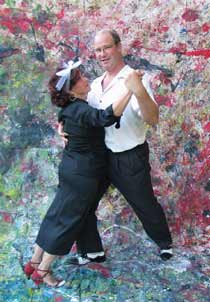
Handy Links
SLAC News Center
SLAC Today
- Subscribe
- Archives: Feb 2006-May 20, 2011
- Archives: May 23, 2011 and later
- Submit Feedback or Story Ideas
- About SLAC Today
SLAC News
Lab News
- Interactions
- Lightsources.org
- ILC NewsLine
- Int'l Science Grid This Week
- Fermilab Today
- Berkeley Lab News
- @brookhaven TODAY
- DOE Pulse
- CERN Courier
- DESY inForm
- US / LHC
SLAC Links
- Emergency
- Safety
- Policy Repository
- Site Entry Form

- Site Maps
- M & O Review
- Computing Status & Calendar
- SLAC Colloquium
- SLACspeak
- SLACspace
- SLAC Logo
- Café Menu
- Flea Market
- Web E-mail
- Marguerite Shuttle
- Discount Commuter Passes
-
Award Reporting Form
- SPIRES
- SciDoc
- Activity Groups
- Library
Stanford
Around the Bay
Carsten Hast
 Twenty years ago, Carsten Hast moved to Hamburg to complete his studies at DESY. When an acquaintance spoke of her plans to open an Argentine Tango studio, Carsten decided to try it. "Within three weeks I was hooked," he said. "It's not me who started it: tango came to me and never let me go."
Twenty years ago, Carsten Hast moved to Hamburg to complete his studies at DESY. When an acquaintance spoke of her plans to open an Argentine Tango studio, Carsten decided to try it. "Within three weeks I was hooked," he said. "It's not me who started it: tango came to me and never let me go."
Once he got over the challenge of not stepping on his own feet, Carsten says Argentine Tango "is a totally different world from ballroom or other Latin dances." Between the communication, emotion, and playfulness required, tango is the most complicated of dances.
Tango partners improvise a sensual dance with each song. They must be willing to display publicly a shared intimate moment on the floor, and to enjoy the moment for itself—as the muffled, sad sound of tango's lead instrument, the bandoneón, imparts a melancholy undertone.
"Tango is a way of looking at your life," muses Carsten, a BaBar physicist and CEF's group leader of research and facilities support. "Anyone who does it cannot be completely happy."
Until three years ago, Carsten organized a weekly tango event in Los Altos. Recently he's broadened his scope to teach classes, shoot video, and design and sew costumes for dancers. His latest event, IndepenDance Day: Pollock meets Piazzolla, was a Fourth of July tribute to the abstract expressionist and the tango composer. Five couples took turns dipping their shoes in paint trays and swirling across a giant canvas cloth.
More than anything, Carsten says he enjoys tango for the people and for its global reach. "Basically there's no town on the planet where you can't dance tango," he says. "It's a pleasant disease that's spread around the world."
—Krista Zala
SLAC Today, August 2, 2006
Above image: Carsten Hast dances with Donna Sotiropoulos. (Click on image for larger version.)